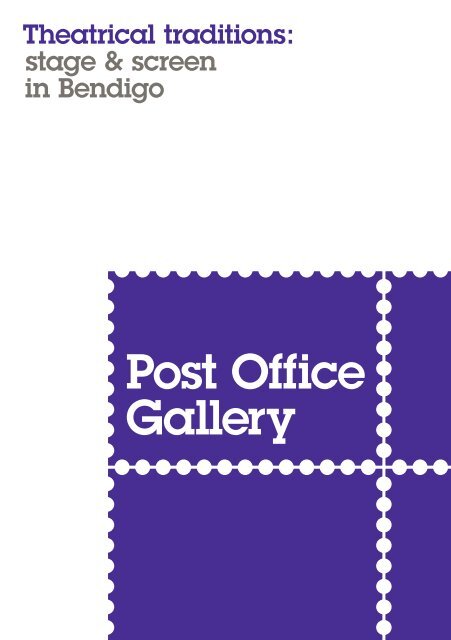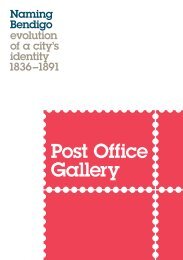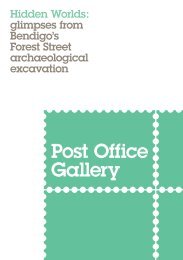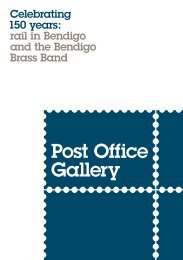Theatrical traditions: stage and screen in Bendigo
This electronic publication accompanies the exhibition Theatrical traditions: stage and screen in Bendigo. Western theatrical traditions came to Bendigo with fortune seekers in the 1850s. Since then, everything from amateur to professional, Shakespeare, opera, live music, eisteddfods, Vaudeville, musicals and comedy have graced the many stages in Bendigo. The beginning of the 20th century heralded the dawn of the motion picture, which by the middle of the century was the most popular form of entertainment. Existing Bendigo theatres quickly adapted and numerous purpose built picture theatres were constructed. Theatrical traditions: stage and screen in Bendigo looked at key moments, venues and people in the evolution of such entertainment in Bendigo.
This electronic publication accompanies the exhibition Theatrical traditions: stage and screen in Bendigo.
Western theatrical traditions came to Bendigo with fortune seekers in the 1850s. Since then, everything from amateur to professional, Shakespeare, opera, live music, eisteddfods, Vaudeville, musicals and comedy have graced the many stages in Bendigo. The beginning of the 20th century heralded the dawn of the motion picture, which by the middle of the century was the most popular form of entertainment. Existing Bendigo theatres quickly adapted and numerous purpose built picture theatres were constructed. Theatrical traditions: stage and screen in Bendigo looked at key moments, venues and people in the evolution of such entertainment in Bendigo.
Create successful ePaper yourself
Turn your PDF publications into a flip-book with our unique Google optimized e-Paper software.
<strong>Theatrical</strong> <strong>traditions</strong>:<br />
<strong>stage</strong> & <strong>screen</strong><br />
<strong>in</strong> <strong>Bendigo</strong><br />
1
a satellite space of<br />
<strong>Bendigo</strong> Art Gallery<br />
42 View Street<br />
<strong>Bendigo</strong>, Victoria 3550<br />
Australia<br />
www.bendigoartgallery.com.au<br />
Published 2015<br />
Copyright © <strong>Bendigo</strong> Art Gallery 2015<br />
This work is copyright. Apart from any use as permitted under the Copyright Act 1968, no part<br />
may be reproduced by any process without prior written permission.<br />
Typeset <strong>and</strong> pr<strong>in</strong>ted <strong>in</strong> Australia by <strong>Bendigo</strong> Modern Press<br />
www.bmp.com.au<br />
National Library of Australia<br />
Catalogu<strong>in</strong>g-<strong>in</strong>-Publication data:<br />
Needham, Clare<br />
<strong>Theatrical</strong> <strong>traditions</strong> : <strong>stage</strong> <strong>and</strong> <strong>screen</strong> <strong>in</strong> <strong>Bendigo</strong><br />
Clare Needham ; <strong>in</strong>troduction by Karen Qu<strong>in</strong>lan; photography by Ian Hill<br />
ISBN: 9780949215802 (pbk)<br />
Theaters--Victoria--<strong>Bendigo</strong>--History.<br />
Motion picture theaters--Victoria--<strong>Bendigo</strong>--History.<br />
<strong>Bendigo</strong> (Vic.)--Build<strong>in</strong>gs, structures, etc.--History.<br />
<strong>Bendigo</strong> (Vic.)--History.<br />
Other Creators/Contributors:<br />
Qu<strong>in</strong>lan, Karen, writer of <strong>in</strong>troduction.<br />
Hill, Ian, photographer.<br />
<strong>Bendigo</strong> Art Gallery<br />
725.82099454<br />
Exhibition venue:<br />
Post Office Gallery, 51-67 Pall Mall, <strong>Bendigo</strong>.<br />
Exhibition dates:<br />
16 October 2015 – 14 March 2016<br />
Post Office Gallery <strong>and</strong> <strong>Bendigo</strong> Art Gallery are proudly<br />
owned <strong>and</strong> operated by the City of Greater <strong>Bendigo</strong>.<br />
2<br />
Media sponsor<br />
Projection room at the<br />
Plaza Theatre (detail)<br />
1967<br />
black <strong>and</strong> white<br />
photograph<br />
Collection Michael<br />
Purden
<strong>Theatrical</strong> <strong>traditions</strong>:<br />
<strong>stage</strong> & <strong>screen</strong><br />
<strong>in</strong> <strong>Bendigo</strong><br />
1
2
Introduction<br />
William<br />
Mar<strong>in</strong>er Bent<br />
Australia fl.<br />
1884-1891<br />
Portrait of a woman<br />
<strong>in</strong> amateur theatrical<br />
costume, S<strong>and</strong>hurst<br />
(detail)<br />
1870s<br />
albumen pr<strong>in</strong>t with<br />
h<strong>and</strong> colour<strong>in</strong>g, carte<br />
de visite format<br />
Collection Douglas<br />
Stewart F<strong>in</strong>e Books<br />
Photograph Tira<br />
Lewis<br />
The longevity <strong>and</strong> vibrancy of the<br />
arts <strong>in</strong> <strong>Bendigo</strong> are fundamental<br />
to the unique character of the city.<br />
Along with the visual arts, the<br />
perform<strong>in</strong>g arts cont<strong>in</strong>ue to flourish,<br />
build<strong>in</strong>g on the legacy of the past.<br />
Recent <strong>in</strong>vestment <strong>in</strong> cultural<br />
<strong>in</strong>frastructure <strong>in</strong>clud<strong>in</strong>g the 2013/14<br />
<strong>Bendigo</strong> Art Gallery redevelopment<br />
<strong>and</strong> the br<strong>and</strong> new Ulumbarra<br />
Theatre only strengthen the richness<br />
of this heritage.<br />
The exhibition <strong>Theatrical</strong> <strong>traditions</strong>:<br />
<strong>stage</strong> <strong>and</strong> <strong>screen</strong> <strong>in</strong> <strong>Bendigo</strong> explores key<br />
moments, venues <strong>and</strong> people <strong>in</strong> the<br />
evolution of theatrical enterta<strong>in</strong>ment<br />
<strong>in</strong> <strong>Bendigo</strong>.<br />
Post Office Gallery’s lenders<br />
<strong>and</strong> supporters are an <strong>in</strong>tegral<br />
part of the success of the Gallery<br />
<strong>and</strong> each exhibition. For their<br />
commitment to the preservation<br />
of our region’s long <strong>and</strong> proud<br />
history <strong>and</strong> their generosity <strong>in</strong><br />
shar<strong>in</strong>g their knowledge, memories<br />
<strong>and</strong> collections, thank you to: The<br />
C<strong>in</strong>ema <strong>and</strong> Theatre Historical<br />
Society of Australia Inc.; <strong>Bendigo</strong><br />
Historical Society; <strong>Bendigo</strong> Regional<br />
Archive Centre, namely Dr Michele<br />
Matthews; <strong>Bendigo</strong> Library; State<br />
Library of Victoria; Eaglehawk<br />
Heritage Society; <strong>Bendigo</strong> Theatre<br />
Company; Douglas Stewart F<strong>in</strong>e<br />
Books; Ron Bilitho, General<br />
Manager, <strong>Bendigo</strong> C<strong>in</strong>emas; Hannah<br />
Morton, Manager <strong>and</strong> Stephen<br />
Maber, projectionist, Star C<strong>in</strong>ema,<br />
Eaglehawk; Kerry Andrea, Records<br />
Officer, City of Greater <strong>Bendigo</strong>;<br />
David Lloyd, Manager, Capital<br />
Venues & Events; Rod Aikman;<br />
Alfred Annison; Helen Attrill;<br />
Ann Ball; Annette Beckwith;<br />
Willi Carney; John Casey; Jenny<br />
Campbell; Grace Cox; Coral Evans;<br />
Julie Howard; Karl Jackson; Yvonne<br />
Johanson; Aylene <strong>and</strong> Graeme<br />
Kirkwood; Tom Luke; Anto<strong>in</strong>ette<br />
Lyon; Jocelyn Lyon; Ruth Lyon;<br />
Michael Purden; Dennis O’Hoy;<br />
Leighton <strong>and</strong> Sue Rawl<strong>in</strong>gs; Leigh<br />
McK<strong>in</strong>non; Margaret Rule-<br />
McQueenie; Mick Stone; Ian Wild<br />
<strong>and</strong> Darren Wright.<br />
Thank you also to the <strong>Bendigo</strong><br />
Heritage Representative Group for<br />
their ongo<strong>in</strong>g support of Post Office<br />
Gallery.<br />
I’d particularly like to thank Clare<br />
Needham, Curator, City History<br />
<strong>and</strong> Collections for curat<strong>in</strong>g this<br />
exhibition <strong>and</strong> for her ongo<strong>in</strong>g<br />
management of Post Office Gallery.<br />
I acknowledge the technical team of<br />
<strong>Bendigo</strong> Art Gallery for <strong>in</strong>stall<strong>in</strong>g<br />
the exhibiton <strong>and</strong> I wish to highlight<br />
especially the Post Office Gallery<br />
volunteers, who make a significant<br />
contribution to visitors’ experience at<br />
the Gallery.<br />
KAREN QUINLAN<br />
DIRECTOR, BENDIGO ART GALLERY<br />
3
<strong>Theatrical</strong> <strong>traditions</strong>:<br />
<strong>stage</strong> & <strong>screen</strong> <strong>in</strong><br />
<strong>Bendigo</strong><br />
Western theatrical <strong>traditions</strong> came<br />
to <strong>Bendigo</strong> with fortune seekers <strong>in</strong><br />
the 1850s. 1 The grow<strong>in</strong>g population<br />
<strong>and</strong> prosperity of the goldfields was<br />
attractive to tour<strong>in</strong>g artists, companies<br />
<strong>and</strong> theatrical entrepreneurs ensur<strong>in</strong>g<br />
that even amongst the dust of the<br />
fledgl<strong>in</strong>g settlement, there was no<br />
shortage of enterta<strong>in</strong>ment. S<strong>in</strong>ce then,<br />
everyth<strong>in</strong>g from amateur to professional,<br />
Shakespeare, opera, music, vaudeville,<br />
drama <strong>and</strong> comedy have graced the<br />
many <strong>stage</strong>s <strong>in</strong> <strong>Bendigo</strong>. The beg<strong>in</strong>n<strong>in</strong>g<br />
of the 20th century heralded the dawn of<br />
motion pictures, which quickly became<br />
the most popular form of enterta<strong>in</strong>ment.<br />
Exist<strong>in</strong>g theatres promptly adapted <strong>and</strong><br />
numerous purpose built picture theatres<br />
were constructed.<br />
Despite the dom<strong>in</strong>at<strong>in</strong>g popularity of<br />
‘the pictures’, live theatre has rema<strong>in</strong>ed<br />
a constant <strong>in</strong> the evolv<strong>in</strong>g story of the<br />
perform<strong>in</strong>g arts <strong>in</strong> <strong>Bendigo</strong>. Amateur<br />
theatre companies, formed <strong>in</strong> the early<br />
days of the city have paved the way<br />
for contemporary community theatre,<br />
which has cont<strong>in</strong>ued to be a strong<br />
creative force <strong>in</strong> the city with several<br />
local companies operat<strong>in</strong>g for decades.<br />
The new state-of-the-art, Ulumbarra<br />
Theatre is the latest addition to the<br />
city’s vibrant cultural scene, testament<br />
to the cont<strong>in</strong>u<strong>in</strong>g celebration of<br />
theatrical <strong>traditions</strong> <strong>in</strong> <strong>Bendigo</strong>.<br />
Endeavor<strong>in</strong>g to cover nearly 165 years<br />
of the theatrical history of a city like<br />
<strong>Bendigo</strong> is quite a task. Needless to<br />
say, <strong>in</strong> a short essay, it is not possible<br />
to highlight every <strong>in</strong>dividual who<br />
has contributed to this history nor<br />
is it possible to go <strong>in</strong>to detail about<br />
the countless films <strong>screen</strong>ed or live<br />
performances held at the numerous<br />
venues across the city. For expediency,<br />
this essay focuses on key moments,<br />
places <strong>and</strong> people, attempt<strong>in</strong>g to briefly<br />
chart the ebb <strong>and</strong> flow of the theatrical<br />
l<strong>and</strong>scape of <strong>Bendigo</strong>.<br />
EARLY DAYS<br />
One need only glance at the front<br />
pages of the <strong>Bendigo</strong> Advertiser from<br />
the early years of settlement to note the<br />
rich diversity of the cities cultural life.<br />
Appeal<strong>in</strong>g to a wide audience regardless<br />
of affluence, live theatre was a popular<br />
form of enterta<strong>in</strong>ment. In the early<br />
days such enterta<strong>in</strong>ment took place <strong>in</strong><br />
tents. However, less than a decade after<br />
gold was discovered <strong>in</strong> <strong>Bendigo</strong>, there<br />
was a variety of establishments offer<strong>in</strong>g<br />
everyth<strong>in</strong>g from bawdy concert hall acts<br />
to theatrical performances comparable<br />
to those be<strong>in</strong>g performed on the <strong>stage</strong>s<br />
of London. 2<br />
4
Benjam<strong>in</strong> Pierce<br />
Batchelder<br />
born United States<br />
1826<br />
arrived Australia 1856<br />
died 1891<br />
Theatre Royal,<br />
Pall Mall, <strong>Bendigo</strong><br />
1861<br />
albumen silver<br />
photograph<br />
Courtesy State<br />
Library of Victoria<br />
THE SHAMROCK HOTEL<br />
In January 1854, Joseph Carncross,<br />
owner of the Royal Exchange<br />
Restaurant opened the Theatre Royal,<br />
a large build<strong>in</strong>g on the site of the current<br />
Shamrock Hotel. Despite the makeshift<br />
nature of the burgeon<strong>in</strong>g township,<br />
there was already competition for<br />
Carncross’ new theatre. A large tent<br />
theatre, The Cas<strong>in</strong>o, was operat<strong>in</strong>g just<br />
down the road also on Pall Mall. Later<br />
<strong>in</strong> 1854, the Pr<strong>in</strong>cess Theatre at the<br />
Criterion Hotel <strong>and</strong> the Royal Victoria<br />
opened <strong>in</strong> nearby Market Square. 3 By<br />
August 1854, both the Royal Exchange<br />
<strong>and</strong> the Theatre Royal were up for sale<br />
<strong>and</strong> were subsequently purchased by<br />
William Heffernan <strong>and</strong> his brother-<strong>in</strong>law<br />
John Crowley. 4<br />
Enterpris<strong>in</strong>g by nature, Heffernan<br />
<strong>and</strong> Crowley erected a new hotel on<br />
the site <strong>and</strong> established with<strong>in</strong> it a<br />
theatre, employ<strong>in</strong>g a regular company<br />
of performers <strong>and</strong> an orchestra. The<br />
Shamrock Concert Hall opened<br />
on 31 March 1855. The ensu<strong>in</strong>g<br />
enterta<strong>in</strong>ment drew on the popularity<br />
of British ‘Variety’ <strong>and</strong> ‘Music Hall’<br />
amusements; a night of mixed acts<br />
featur<strong>in</strong>g s<strong>in</strong>gers, comedians, dancers,<br />
actors <strong>and</strong> sometimes acrobats, or<br />
magicians. Such amusements, appealed<br />
to the work<strong>in</strong>g-class sensibilities of the<br />
majority of the audience who attended<br />
nightly performances.<br />
The concert hall was a great success<br />
<strong>and</strong> was quickly the most lucrative<br />
part of the Shamrock enterprise. The<br />
profits, primarily from the sale of<br />
liquor, facilitated lavish enterta<strong>in</strong>ment<br />
<strong>and</strong> enabled the establishment to offer<br />
free entry to patrons <strong>and</strong> secure some<br />
of the lead<strong>in</strong>g tour<strong>in</strong>g artists of the<br />
day. Renovations <strong>and</strong> enlargement of<br />
the hall took place <strong>in</strong> 1856, but on<br />
Christmas Day of 1857, the Shamrock<br />
was severely damaged by fire.<br />
Renowned local architect William<br />
Charles Vahl<strong>and</strong> <strong>and</strong> his bus<strong>in</strong>ess<br />
partner Robert Getzschmann were<br />
employed to design a new build<strong>in</strong>g <strong>and</strong><br />
the hotel was re-built. The impressive<br />
new three-storey Shamrock Hotel<br />
was opened <strong>in</strong> 1860. Dur<strong>in</strong>g the redevelopment,<br />
the concert hall was redesigned<br />
to accommodate 800 people<br />
<strong>and</strong> tak<strong>in</strong>g <strong>in</strong>to account the chang<strong>in</strong>g<br />
tastes of the <strong>in</strong>creas<strong>in</strong>gly cosmopolitan<br />
audience, it was once aga<strong>in</strong> named, the<br />
Theatre Royal.<br />
THE CRITERION THEATRE<br />
A few blocks away, the Pr<strong>in</strong>cess<br />
Theatre, capable of seat<strong>in</strong>g 300 people,<br />
occupied the entire top floor of the<br />
Criterion Hotel, which, as previously<br />
mentioned, opened <strong>in</strong> Market Square<br />
<strong>in</strong> 1854. 5 The hotel set a high st<strong>and</strong>ard<br />
<strong>and</strong> quickly became the social hub of<br />
5
6<br />
Benjam<strong>in</strong> Pierce<br />
Batchelder<br />
born United States<br />
1826<br />
arrived Australia 1856<br />
died 1891<br />
Symonds’ Criterion<br />
Family Hotel, <strong>Bendigo</strong><br />
1861<br />
albumen silver<br />
photograph<br />
Courtesy State<br />
Library of Victoria<br />
Lola Montez<br />
c1846 - c1861<br />
Reproduction of<br />
portrait pa<strong>in</strong>ted<br />
by order of K<strong>in</strong>g<br />
Ludwig I of Bavaria<br />
Reproduced<br />
from the book<br />
Seven Splendid S<strong>in</strong>ners<br />
by W R H<br />
Trowbridge<br />
Courtesy State<br />
Library of Victoria<br />
‘cultured’ citizens. Henry Coleman,<br />
respected for his enterpris<strong>in</strong>g spirit<br />
<strong>and</strong> ability to procure high-quality<br />
enterta<strong>in</strong>ment, managed the Pr<strong>in</strong>cess<br />
Theatre. While cont<strong>in</strong>u<strong>in</strong>g <strong>in</strong> this role,<br />
<strong>in</strong> 1856, Coleman built the Criterion<br />
Theatre on a site adjo<strong>in</strong><strong>in</strong>g the Hotel.<br />
By contemporary st<strong>and</strong>ards the build<strong>in</strong>g<br />
was rudimentary, but at the time its<br />
scale alone would have been impressive.<br />
With a capacity of 1500, accord<strong>in</strong>g to<br />
the <strong>Bendigo</strong> Advertiser <strong>and</strong> Coleman’s<br />
supporters, the new theatre was<br />
‘unparalleled for comfort <strong>and</strong> elegance<br />
<strong>in</strong> the colony...’<strong>and</strong> ‘unrivalled by<br />
any Colonial Prov<strong>in</strong>cial Theatre…’ 6<br />
By 1857, the Criterion Theatre had<br />
been re-named the Haymarket Theatre,<br />
<strong>and</strong> surpris<strong>in</strong>gly, only four years later,<br />
it was sold at auction <strong>and</strong> subsequently<br />
demolished. 7<br />
The most legendary performer to grace<br />
the <strong>stage</strong> at the Criterion was actress<br />
Lola Montez. 8 Born Marie Dolores<br />
Eliza Rosanna Gilbert, the Irish dancer<br />
<strong>and</strong> actress became famous as Lola<br />
Montez the ‘Spanish dancer’. She<br />
received mixed reviews throughout<br />
her checkered theatrical career.<br />
Montez toured the goldfields of<br />
Australia <strong>in</strong> 1855 – 56. Her antics,<br />
both on <strong>and</strong> off <strong>stage</strong>, ga<strong>in</strong>ed her quite<br />
a reputation <strong>and</strong> her arrival <strong>in</strong> <strong>Bendigo</strong><br />
<strong>in</strong> March 1856 was highly anticipated.<br />
Many attended her performances out<br />
of sheer curiosity; others were <strong>in</strong>tent<br />
on witness<strong>in</strong>g her legendary risqué<br />
‘Spider Dance’. 9 One of the most<br />
notable events dur<strong>in</strong>g Montez’s time<br />
<strong>in</strong> <strong>Bendigo</strong> was on 1 April when the<br />
Criterion was struck by lighten<strong>in</strong>g<br />
dur<strong>in</strong>g her performance. The<br />
lighten<strong>in</strong>g entered the build<strong>in</strong>g <strong>and</strong> set<br />
fire to some of the scenery. 10 Montez<br />
rema<strong>in</strong>ed <strong>in</strong> <strong>Bendigo</strong> for several<br />
months. Address<strong>in</strong>g the audience at<br />
the end of one of her performances<br />
declar<strong>in</strong>g that she ‘…would not soon<br />
forget the k<strong>in</strong>dness she met with on<br />
<strong>Bendigo</strong>’. 11<br />
ABBOTT’S LYCEUM<br />
Abbott’s Hotel, operat<strong>in</strong>g <strong>in</strong> the early<br />
days of <strong>Bendigo</strong>, was a two-storey<br />
build<strong>in</strong>g near the corner of Bull Street<br />
<strong>and</strong> Pall Mall. Attached to the hotel<br />
was a small theatre known as the<br />
Lyceum. By 1860, Abbott had closed<br />
the adjo<strong>in</strong><strong>in</strong>g theatre <strong>and</strong> re-built it.<br />
The ambitious New Lyceum Theatre<br />
opened on the 10 December 1860.<br />
With a capacity of 1500, it boasted<br />
a large <strong>stage</strong> framed by an equally<br />
generous proscenium. 12 The launch<strong>in</strong>g<br />
act was Signor <strong>and</strong> Signor<strong>in</strong>a Bianchi<br />
perform<strong>in</strong>g the opera Il Travatore.<br />
The Lyceum was the most well<br />
regarded theatre <strong>in</strong> <strong>Bendigo</strong> at the
7
8<br />
First Benefit on<br />
S<strong>and</strong>hurst of the<br />
sisters Ada &<br />
Fanny Hart at the<br />
Lyceum Theatre,<br />
theatre ticket<br />
1869<br />
lithographic pr<strong>in</strong>t<br />
Collection Rod<br />
Aikman<br />
Image courtesy<br />
Douglas Stewart<br />
F<strong>in</strong>e Books<br />
Photograph<br />
Tira Lewis<br />
time. Unlike the variety enterta<strong>in</strong>ment<br />
that was common at establishments like<br />
the Shamrock, the Lyceum’s program<br />
<strong>in</strong>cluded opera, Shakespeare <strong>and</strong> other<br />
plays from the English repertoire<br />
attract<strong>in</strong>g a more cultured audience.<br />
Ch<strong>in</strong>ese opera was also performed<br />
annually at the Lyceum, often <strong>in</strong> aid<br />
of the Asylum or Hospital. 13 Despite<br />
its reputation <strong>and</strong> achievements, <strong>in</strong><br />
1872, like those before it, the Lyceum<br />
closed.<br />
ST JAMES’ HALL<br />
In the 1870s with the clos<strong>in</strong>g of<br />
the Lyceum <strong>and</strong> the <strong>in</strong>creas<strong>in</strong>g<br />
sophistication of theatre-goers, there<br />
was grow<strong>in</strong>g concern about the need<br />
for a first-class theatre worthy of a city<br />
such as <strong>Bendigo</strong>. Heffernan’s solution<br />
was to build St James Hall on a narrow<br />
site directly opposite The Shamrock<br />
Hotel. 14 The <strong>Bendigo</strong> Philharmonic<br />
Society opened the hall on 8 April<br />
1873 with a performance of H<strong>and</strong>el’s<br />
Judas Maccabeus. 15 The venture was<br />
short lived however, as Heffernan put<br />
his energy <strong>in</strong>to the construction of the<br />
Royal Pr<strong>in</strong>cess Theatre just up the hill<br />
on View Street.<br />
THE ROYAL PRINCESS THEATRE<br />
The Royal Pr<strong>in</strong>cess Theatre opened<br />
on 31 August 1874 with a performance<br />
of The Gr<strong>and</strong> Duchess of Gerolste<strong>in</strong> just<br />
months after its Paris premier. 16 Situated<br />
on View Street, the theatre was designed<br />
by Vahl<strong>and</strong> <strong>and</strong> Getzschmann. 17 With<br />
a seat<strong>in</strong>g capacity of 2000 spread across<br />
three levels <strong>and</strong> six <strong>stage</strong> boxes, its scale<br />
<strong>and</strong> elegance rivaled capital city theatres<br />
<strong>and</strong> successfully satisfied community<br />
aspirations for a premium theatre.<br />
In the late 19th <strong>and</strong> early 20th centuries<br />
everyth<strong>in</strong>g from vauderville to classical<br />
theatrical productions, pantomimes,<br />
vocal <strong>and</strong> music recitals, opera, ballet<br />
<strong>and</strong> elocutionary competitions were<br />
presented on the Royal Pr<strong>in</strong>cess’ <strong>stage</strong><br />
with a constant stream of reputed local,<br />
national <strong>and</strong> <strong>in</strong>ternational artists <strong>and</strong><br />
tour<strong>in</strong>g companies to susta<strong>in</strong> them.<br />
Many well-known performers stopped<br />
off <strong>in</strong> <strong>Bendigo</strong> to perform at the Royal<br />
Pr<strong>in</strong>cess Theatre on their Australian<br />
tours. 18<br />
One such celebrity was Dame Nellie<br />
Melba who performed <strong>in</strong> <strong>Bendigo</strong> on<br />
several occasions. Her first visit was <strong>in</strong><br />
February 1889, her second <strong>in</strong> 1908.<br />
Dur<strong>in</strong>g this second visit, like many<br />
of her colleagues, Melba stayed at the<br />
most reputable accommodation of<br />
the day, the Shamrock Hotel. Legend<br />
has it that she was so irritated by the<br />
constant chim<strong>in</strong>g of the Post Office<br />
clock opposite her w<strong>in</strong>dow, she asked<br />
for the clock to be stopped so she could<br />
get some sleep. Her last appearance<br />
<strong>in</strong> <strong>Bendigo</strong> was a farewell concert at
W V<strong>in</strong>cent Kelly<br />
Australia<br />
active 1904 – 1958<br />
Miss Dolly Castles as<br />
Phyllis <strong>in</strong> Iolanthe<br />
c1906<br />
postcard<br />
Talma & Co.<br />
Melbourne & Sydney<br />
c1895 - c1915<br />
Dolly Castles<br />
c1906<br />
postcard, pa<strong>in</strong>t, glitter<br />
Amy Castles<br />
c1906<br />
postcard<br />
Collection Dennis<br />
O’Hoy<br />
the Royal Pr<strong>in</strong>cess on 23 September<br />
1921.<br />
Well-known local soprano Amy Castles<br />
also performed at the Royal Pr<strong>in</strong>cess <strong>in</strong><br />
the early 20th century. Over the years,<br />
much talent has hailed from <strong>Bendigo</strong>,<br />
yet few have lived on <strong>in</strong> collective<br />
memory like Amy Castles. 19 One of<br />
her earliest public performances was <strong>in</strong><br />
a <strong>Bendigo</strong> production of Gilbert <strong>and</strong><br />
Sullivan’s Patience <strong>in</strong> 1898. And at the<br />
age of 19 she performed at Queen’s<br />
Hall, London. 20<br />
At the turn of the century, a career<br />
<strong>in</strong> the theatre had become more<br />
acceptable for women. Once<br />
associated with loose morals (th<strong>in</strong>k<br />
Lola Montez), thanks to pioneer<strong>in</strong>g<br />
female performers, such as Dame<br />
Nellie Melba, exploit<strong>in</strong>g musical talent<br />
became a legitimate way of ga<strong>in</strong><strong>in</strong>g<br />
f<strong>in</strong>ancial <strong>in</strong>dependence <strong>and</strong> celebrity. 21<br />
Throughout her career, Amy Castles<br />
was often compared to Melba, but<br />
despite be<strong>in</strong>g enthusiastically received<br />
by audiences <strong>in</strong> Australia <strong>and</strong> overseas,<br />
<strong>and</strong> energetically promoted by the<br />
press, she never quite achieved the<br />
same success <strong>and</strong> stopped perform<strong>in</strong>g<br />
publically <strong>in</strong> the 1930s. 22<br />
Deemed to be unsafe by the Board<br />
of Health, <strong>in</strong> January 1904 the Royal<br />
Pr<strong>in</strong>cess closed to undergo renovations.<br />
It re-opened <strong>in</strong> April the follow<strong>in</strong>g<br />
year <strong>and</strong> cont<strong>in</strong>ued with a full <strong>and</strong><br />
varied program <strong>in</strong>clud<strong>in</strong>g motion<br />
pictures until its eventual closure <strong>and</strong><br />
demolition <strong>in</strong> 1963.<br />
THE MASONIC THEATRE<br />
Open<strong>in</strong>g just two months after the<br />
Royal Pr<strong>in</strong>cess <strong>in</strong> 1874 <strong>and</strong> situated just<br />
up the hill on the other side of View<br />
Street, was the Masonic Hall (now<br />
the Capital Theatre). The Golden<br />
<strong>and</strong> Cor<strong>in</strong>thian Masonic Lodges<br />
had purchased the l<strong>and</strong> at an 1866<br />
Government auction. The foundation<br />
stone was laid on 24 June 1873 <strong>and</strong><br />
the strik<strong>in</strong>g build<strong>in</strong>g completed the<br />
follow<strong>in</strong>g year. Designed by Vahl<strong>and</strong> 23<br />
<strong>and</strong> Getzschmann, it was touted at the<br />
time, as ‘... the f<strong>in</strong>est Masonic Hall <strong>in</strong><br />
Australia … [with] the advantage of<br />
hav<strong>in</strong>g been erected on the very best<br />
site of the city, <strong>and</strong> … seen from every<br />
po<strong>in</strong>t for a long distance’. 24<br />
Public access was restricted to the<br />
downstairs ‘Tavern’ (later known<br />
as the ‘Masonic Shades Hotel’) 25<br />
<strong>and</strong> an upstairs room was used as a<br />
ballroom <strong>and</strong> concert hall. An array<br />
of enterta<strong>in</strong>ment was provided <strong>in</strong> the<br />
upstairs space, <strong>in</strong>clud<strong>in</strong>g opera, plays,<br />
lectures, recitals <strong>and</strong> balls. Later with<br />
the advent of the ‘picture show’, silent<br />
movies were also <strong>screen</strong>ed here.<br />
In 1890, a time many saw as the<br />
golden years of live theatre <strong>in</strong><br />
<strong>Bendigo</strong>, the Masons undertook<br />
9
10<br />
Masonic Theatre,<br />
View Street<br />
1909<br />
postcard<br />
Collection Dennis<br />
O’Hoy<br />
a major refurbishment <strong>and</strong> the<br />
Masonic Theatre was built. A strip<br />
of l<strong>and</strong> runn<strong>in</strong>g between the orig<strong>in</strong>al<br />
build<strong>in</strong>g <strong>and</strong> the adjacent fire<br />
brigade property was purchased <strong>and</strong><br />
Vahl<strong>and</strong> <strong>and</strong> Getzschmann were once<br />
aga<strong>in</strong> commissioned to design the<br />
amendments which <strong>in</strong>cluded revers<strong>in</strong>g<br />
the orig<strong>in</strong>al configuration of the<br />
ballroom <strong>and</strong> concert hall to transform<br />
it <strong>in</strong>to a more suitable theatre with a<br />
large proscenium <strong>and</strong> a new <strong>stage</strong>.<br />
On the open<strong>in</strong>g day 2 April 1890, the<br />
<strong>Bendigo</strong> Advertiser reported:<br />
The new Masonic Hall Theatre,<br />
which will be formally opened this<br />
even<strong>in</strong>g, will meet a long felt want<br />
<strong>in</strong> this city, particularly for concerts<br />
<strong>and</strong> light dramatic enterta<strong>in</strong>ments,<br />
for which the Royal Pr<strong>in</strong>cess<br />
Theatre is altogether too large. Its<br />
central position to the population,<br />
comb<strong>in</strong>ed with the fact that it one of<br />
the prettiest <strong>and</strong> best-appo<strong>in</strong>ted little<br />
theatres to be met with <strong>in</strong> any of the<br />
pr<strong>in</strong>cipal towns, should make it a<br />
convenient <strong>and</strong> favorite resort to the<br />
amusement lov<strong>in</strong>g public…that the<br />
house will be packed to overflow<strong>in</strong>g<br />
is not too much to prophesy. 26<br />
The theatre’s name was changed to the<br />
New Britannia <strong>in</strong> 1912 <strong>and</strong> the Capital<br />
Theatre <strong>in</strong> the 1930s.<br />
OPEN AIR PICTURE THEATRES<br />
By the beg<strong>in</strong>n<strong>in</strong>g of the 20th century,<br />
The Masonic <strong>and</strong> Royal Pr<strong>in</strong>cess<br />
Theatres had quickly embraced the<br />
phenomenon of mov<strong>in</strong>g pictures with<br />
the former host to some of the first<br />
film <strong>screen</strong><strong>in</strong>gs <strong>in</strong> <strong>Bendigo</strong> courtesy<br />
of pioneer<strong>in</strong>g travell<strong>in</strong>g picture showmen.<br />
27 Such films were black <strong>and</strong><br />
white <strong>and</strong> silent with live musical<br />
accompaniment; a s<strong>in</strong>gle piano or a full<br />
orchestra.<br />
An immediate hit with audiences<br />
mov<strong>in</strong>g pictures transitioned quickly<br />
from be<strong>in</strong>g a novelty, sometimes<br />
<strong>screen</strong>ed as filler between Vaudeville<br />
acts, to be<strong>in</strong>g the ma<strong>in</strong> event. It did<br />
not take long for ‘picture shows’ to<br />
become a permanent fixture <strong>in</strong> the<br />
daily amusements columns of the<br />
<strong>Bendigo</strong> Advertiser. As well as the two<br />
major theatres <strong>in</strong> town, films were also<br />
<strong>screen</strong>ed <strong>in</strong> municipal halls, mechanics<br />
<strong>in</strong>stitutes <strong>and</strong> several open-air venues.<br />
As early as 1908, well-known<br />
Australian theatre promoters, J & N<br />
Tait, who had ga<strong>in</strong>ed a reputation<br />
tour<strong>in</strong>g celebrities such as Amy Castles<br />
around the country, were show<strong>in</strong>g<br />
films <strong>in</strong> <strong>Bendigo</strong>. 28 In March 1909,<br />
they took up a short-term lease at the<br />
Royal Pr<strong>in</strong>cess Theatre <strong>and</strong> a year later<br />
opened the Tivoli open-air theatre<br />
beh<strong>in</strong>d the ANA Hall on View Street.
Pathé<br />
France 1896 – current<br />
H<strong>and</strong> cranked reel-to-reel<br />
film projector with 35mm<br />
film on two reels<br />
c1913<br />
metal, plastic, leather<br />
Collection Michael<br />
Purden<br />
11
‘...films at His Majesty’s<br />
were typically <strong>screen</strong>ed<br />
every even<strong>in</strong>g at 8pm,<br />
accompanied by the<br />
house orchestra.’<br />
A full orchestra accompanied the films<br />
<strong>and</strong> if the weather was poor films were<br />
<strong>screen</strong>ed at the Royal Pr<strong>in</strong>cess.<br />
Preced<strong>in</strong>g the Tivoli on 10 November<br />
1909, theatrical entrepreneur, TJ<br />
West of West’s Pictures opened<br />
His Majesty’s Open-air Theatre on<br />
Market Street. In the lead up to the<br />
highly anticipated event, the <strong>Bendigo</strong><br />
Advertiser reported:<br />
Mr. Joseph Howard, representative<br />
of the world-famed West’s Pictures,<br />
arrived <strong>in</strong> <strong>Bendigo</strong> on Saturday<br />
night to make arrangements for the<br />
open<strong>in</strong>g of His Majesty’s Open-air<br />
Theatre… He br<strong>in</strong>gs with him the<br />
latest <strong>and</strong> most up-to-date electric<br />
motor plant, which will supply<br />
the light for the projection of the<br />
pictures… Mr. T. J. West means<br />
to out do all previous attempts at<br />
mov<strong>in</strong>g pictures <strong>in</strong> this city, so the<br />
lovers of this class of enterta<strong>in</strong>ment<br />
may look forward to a treat. The<br />
<strong>screen</strong>, which will be used, is said to<br />
be the largest <strong>in</strong> Australia. 29<br />
Much like Tait’s Pictures at the Tivoli,<br />
films at His Majesty’s were typically<br />
<strong>screen</strong>ed every even<strong>in</strong>g at 8pm,<br />
accompanied by the house orchestra. If<br />
it was wet the program was <strong>screen</strong>ed at<br />
an <strong>in</strong>door venue such as the Masonic<br />
Theatre. West’s Pictures also <strong>screen</strong>ed<br />
films at Jeffrey’s Hall, Eaglehawk <strong>and</strong><br />
Tait’s Pictures at the Eaglehawk Town<br />
Hall.<br />
In February 1911, thank<strong>in</strong>g the<br />
<strong>Bendigo</strong> public for their generous<br />
support over their first 16 months<br />
of operation, the then proprietors<br />
of West’s Pictures at His Majesty’s<br />
Theatre published an announcement <strong>in</strong><br />
the <strong>Bendigo</strong> Advertiser reveal<strong>in</strong>g they<br />
had taken a long lease on a premises<br />
on Pall Mall formerly known as the<br />
Olympia Skat<strong>in</strong>g R<strong>in</strong>k. They <strong>in</strong>tended<br />
to re-seat <strong>and</strong> decorate the build<strong>in</strong>g <strong>in</strong><br />
‘first class style’ to transform it <strong>in</strong>to a<br />
‘modern Picture House’ which would<br />
be called ‘The Lyric Theatre’. The<br />
announcement concluded with the<br />
follow<strong>in</strong>g statement: ‘From this date<br />
should the weather be unfavorable<br />
for outdoor expositions, West’s<br />
Pictures will be <strong>screen</strong>ed <strong>in</strong> the above<br />
theatre’. 30<br />
THE LYRIC THEATRE<br />
The Lyric Theatre on Pall Mall opened<br />
<strong>in</strong> April 1911. Later that year, alongside<br />
live theatrical acts, mov<strong>in</strong>g pictures<br />
were <strong>screen</strong>ed at the theatre not just if<br />
it was cold or wet, but as a permanent<br />
feature. The said proprietors cont<strong>in</strong>ued<br />
to run both the Lyric <strong>and</strong> His Majesty’s<br />
theatres.<br />
12
V<strong>in</strong>cent Kelly<br />
Australia<br />
active 1904 – 1958<br />
Gr<strong>and</strong> open<strong>in</strong>g of the<br />
Lyric Theatre, Char<strong>in</strong>g<br />
Cross<br />
1913<br />
Reproduced from the<br />
<strong>Bendigo</strong> Advertiser<br />
Courtesy Darren<br />
Wright<br />
Despite compet<strong>in</strong>g with several other<br />
picture theatres <strong>in</strong> town, the bus<strong>in</strong>ess<br />
fared well <strong>and</strong> a new site just a few<br />
blocks down Pall Mall at Char<strong>in</strong>g<br />
Cross was procured to build a br<strong>and</strong><br />
new purpose-built theatre for <strong>screen</strong><strong>in</strong>g<br />
films. The first of its k<strong>in</strong>d <strong>in</strong> <strong>Bendigo</strong><br />
the new Lyric Theatre, operated by<br />
Lyric Photo Plays Ltd, opened on<br />
Monday 24 February 1913, with a<br />
<strong>screen</strong><strong>in</strong>g of The Midnight Wedd<strong>in</strong>g. 31<br />
Well-known <strong>Bendigo</strong> family, the<br />
Favaloro’s, operated a concession st<strong>and</strong><br />
on the ground floor, which was also<br />
the box office. 32<br />
Designed by local architects Keogh<br />
<strong>and</strong> Austen, upon open<strong>in</strong>g, the Lyric<br />
was considered the most modern <strong>and</strong><br />
spacious regional theatre <strong>in</strong> the State.<br />
With both Char<strong>in</strong>g Cross <strong>and</strong> Bath<br />
Lane frontage, it seated 1600 people<br />
<strong>and</strong> even though its <strong>in</strong>terior was not<br />
as lavish as other theatres <strong>in</strong> town,<br />
it showed excellent films, ensur<strong>in</strong>g<br />
it quickly became an audience<br />
favourite.<br />
NEW TECHNOLOGIES<br />
The Lyric cont<strong>in</strong>ued to <strong>screen</strong> a steady<br />
stream of silent films with musical<br />
accompaniment until the <strong>in</strong>troduction<br />
of sound on film <strong>in</strong> 1929. Embrac<strong>in</strong>g<br />
the new ‘talkies’, <strong>in</strong> 1930, a state-ofthe-art,<br />
Western Electric sound system<br />
was <strong>in</strong>stalled <strong>and</strong> the first ‘talkie’, Song<br />
of My Heart starr<strong>in</strong>g John McCormick,<br />
<strong>screen</strong>ed at the Lyric.<br />
A couple of months earlier, on Easter<br />
Saturday, the first ‘talkies’ opened at<br />
the Pr<strong>in</strong>cess Theatre with the film The<br />
Desert Song. At this <strong>stage</strong>, sound was not<br />
embedded <strong>in</strong> the film stock, but was<br />
played from a record on an attachment<br />
at the back of the projector. If a piece<br />
of film needed to be removed due to<br />
fault or burn, a piece of blank film had<br />
to be <strong>in</strong>serted <strong>in</strong> order for the sound<br />
<strong>and</strong> vision to rema<strong>in</strong> <strong>in</strong> sync. 33<br />
The <strong>in</strong>troduction of sound on film<br />
triggered a re-evaluation of c<strong>in</strong>ema<br />
design <strong>and</strong> acoustics became a<br />
fundamental consideration. Due to<br />
its dated design for c<strong>in</strong>ema use, the<br />
Pr<strong>in</strong>cess Theatre was closed for remodel<strong>in</strong>g<br />
<strong>in</strong> October 1936. The<br />
architectural firm employed to reth<strong>in</strong>k<br />
its design was Cowper, Murphy<br />
<strong>and</strong> Appleford who chose to replace<br />
the exist<strong>in</strong>g decorative <strong>in</strong>terior with<br />
the clean l<strong>in</strong>es <strong>and</strong> simplified surfaces<br />
of Art Deco. The new-look Pr<strong>in</strong>cess<br />
opened on 4 December 1936 with a<br />
<strong>screen</strong><strong>in</strong>g of Front Page Woman.<br />
Keep<strong>in</strong>g up with the competition,<br />
designed by Melbourne architects<br />
Taylor, Soilleux <strong>and</strong> Overend, <strong>in</strong><br />
1934 extensive alterations also took<br />
place at the Lyric convert<strong>in</strong>g it <strong>in</strong>to a<br />
13
15<br />
15
16<br />
Previous page:<br />
Commercial<br />
Photographic Co.<br />
20th century<br />
Exterior view of the<br />
Pr<strong>in</strong>cess Theatre, View<br />
Street<br />
1936<br />
black <strong>and</strong> white<br />
photograph<br />
Courtesy Harold<br />
Paynt<strong>in</strong>g Collection,<br />
State Library of<br />
Victoria<br />
Lyle Fowler<br />
Australia 1891 – 1969<br />
Exterior view of the<br />
Plaza Theatre, Mitchell<br />
Street<br />
1936<br />
black <strong>and</strong> white<br />
photograph<br />
Courtesy Harold<br />
Paynt<strong>in</strong>g Collection,<br />
State Library of<br />
Victoria<br />
comfortable up-to-date picture theatre.<br />
Modern conveniences such as heat<strong>in</strong>g<br />
<strong>and</strong> cool<strong>in</strong>g were <strong>in</strong>stalled <strong>in</strong>clud<strong>in</strong>g<br />
heated foot-warmers; purported to be<br />
the best method of ma<strong>in</strong>ta<strong>in</strong><strong>in</strong>g the<br />
body at a consistent temperature! 34<br />
The biggest development to<br />
revolutionalise the film <strong>in</strong>dustry s<strong>in</strong>ce<br />
sound on film was C<strong>in</strong>emaScope.<br />
In 1954 the Lyric became the first<br />
<strong>in</strong>dependent theatre <strong>in</strong> Victoria to<br />
<strong>in</strong>stall the wide<strong>screen</strong> technology <strong>and</strong><br />
<strong>in</strong> September of that year, launched<br />
with a highly anticipated gala event,<br />
<strong>in</strong>clud<strong>in</strong>g a <strong>screen</strong><strong>in</strong>g of The Robe. The<br />
C<strong>in</strong>emaScope system was developed <strong>in</strong><br />
Hollywood by 20th Century-Fox <strong>and</strong><br />
resulted <strong>in</strong> an image that was almost<br />
two <strong>and</strong> a half times as wide as it was<br />
high. A new ‘miracle mirror <strong>screen</strong>’<br />
was <strong>in</strong>stalled at the Lyric to cater for the<br />
new C<strong>in</strong>emaScope films. Soon after,<br />
the Royal Pr<strong>in</strong>cess <strong>and</strong> Plaza Theatre<br />
just across Bath Lane from the Lyric,<br />
followed suit refurbish<strong>in</strong>g to <strong>in</strong>corporate<br />
the new wide<strong>screen</strong> technology.<br />
PLAZA THEATRE<br />
The Plaza Theatre opened with a<br />
gala event on 28 December 1934. In<br />
addition to the feature movie Little<br />
Miss Marker starr<strong>in</strong>g Shirley Temple<br />
<strong>and</strong> the associate feature We’re Not<br />
Dress<strong>in</strong>g starr<strong>in</strong>g B<strong>in</strong>g Crosby, the<br />
highlight was the newsreel show<strong>in</strong>g<br />
the wedd<strong>in</strong>g of the Duke of Kent. 35 In<br />
the <strong>in</strong>augural program, address<strong>in</strong>g the<br />
citizens of <strong>Bendigo</strong>, Manag<strong>in</strong>g Director<br />
JL Thornley wrote:<br />
Proudly we present to you a temple<br />
dedicated to the best <strong>in</strong> motion<br />
picture enterta<strong>in</strong>ment. My company<br />
has endeavoured to give you a<br />
theatre that <strong>Bendigo</strong> will be proud<br />
to own. Our ideal has been founded<br />
on comfortable, healthy <strong>and</strong> pleasant<br />
surround<strong>in</strong>gs, with special attention<br />
to ventilation, cool<strong>in</strong>g <strong>and</strong> heat<strong>in</strong>g<br />
<strong>and</strong> strict cleanl<strong>in</strong>ess. We have<br />
endeavoured to build a Theatre that<br />
will be a happy rendezvous for each<br />
<strong>and</strong> everyone of you – every week<br />
<strong>in</strong> the year. 36<br />
The Plaza was located on a narrow strip<br />
of l<strong>and</strong> on the corner of Mitchell Street<br />
<strong>and</strong> Bath Lane with the ma<strong>in</strong> entrance<br />
on Mitchell Street. 37 The theatre was<br />
designed by the architecture firm<br />
Cowper, Murphy <strong>and</strong> Appleford (the<br />
same firm which had designed the<br />
refurbishment of the Pr<strong>in</strong>cess) <strong>and</strong> had<br />
a seat<strong>in</strong>g capacity of 1164. Unlike the<br />
popular Art Deco style of the Pr<strong>in</strong>cess<br />
<strong>and</strong> most other picture theatres be<strong>in</strong>g<br />
built at the time, the <strong>in</strong>terior of the<br />
Plaza was elaborately embellished <strong>in</strong> an<br />
opulent Neo-Gothic style.
Michael Purden <strong>in</strong> the<br />
Plaza Theatre projection<br />
room<br />
1960<br />
black <strong>and</strong> white<br />
photograph<br />
Department of<br />
Public Health<br />
Victoria 1921 –<br />
current<br />
C<strong>in</strong>ematograph<br />
Operators Regulations,<br />
Approval of a Tra<strong>in</strong>ee,<br />
Michael Purden<br />
1960s<br />
card, paper, <strong>in</strong>k<br />
Collection Michael<br />
Purden<br />
17
18<br />
The Rose<br />
Stereograph Co.<br />
Armadale, Victoria<br />
1880 - current<br />
Eaglehawk Town Hall,<br />
the Rose series p3143<br />
1918<br />
postcard<br />
Collection Dennis<br />
O’Hoy<br />
Retired projectionist Michael Purden<br />
began his career at The Plaza at the age<br />
of 15. Eager to get a job <strong>in</strong> the theatre,<br />
he remembers pester<strong>in</strong>g the managers<br />
of the Plaza, Lyric <strong>and</strong> Pr<strong>in</strong>cess to<br />
<strong>in</strong>itially get a job as a lolly boy carry<strong>in</strong>g<br />
a tray of lollies <strong>and</strong> ice-creams around<br />
the auditorium dur<strong>in</strong>g <strong>in</strong>terval. The<br />
manager of The Plaza gave him a shot<br />
<strong>and</strong> from his lolly boy beg<strong>in</strong>n<strong>in</strong>gs, <strong>in</strong><br />
1959, he became a tra<strong>in</strong>ee projectionist.<br />
Mov<strong>in</strong>g from The Plaza to the Golden<br />
Drive-In <strong>in</strong> 1962, he completed his<br />
tra<strong>in</strong><strong>in</strong>g, sitt<strong>in</strong>g for his full operator’s<br />
license when he turned 21. Michael<br />
rema<strong>in</strong>ed work<strong>in</strong>g as a projectionist<br />
until he retired <strong>in</strong> 2009. 38 He was one<br />
of six long serv<strong>in</strong>g projectionists at The<br />
Plaza <strong>in</strong>clud<strong>in</strong>g Bob Johnson, Perc<br />
Woodyard, Max Morse, John Leggo<br />
<strong>and</strong> Ken Hill.<br />
As <strong>in</strong>itially hoped, The Plaza was a<br />
popular theatre <strong>and</strong> many who grew<br />
up <strong>in</strong> <strong>Bendigo</strong> have fond memories<br />
of ’go<strong>in</strong>g to the pictures’ there. Jack<br />
Campbell affectionately known as<br />
‘Plaza Jack’ features <strong>in</strong> many of these<br />
memories. Campbell worked at The<br />
Plaza for more than 25 years, bill<br />
post<strong>in</strong>g, work<strong>in</strong>g <strong>in</strong> the projection<br />
room <strong>and</strong> act<strong>in</strong>g as a bouncer keep<strong>in</strong>g<br />
rowdy kids <strong>in</strong> l<strong>in</strong>e. Theatre <strong>and</strong> film<br />
were his life.<br />
EAGLEHAWK PICTURES<br />
Mov<strong>in</strong>g pictures were be<strong>in</strong>g shown <strong>in</strong><br />
Eaglehawk from the time they arrived<br />
<strong>in</strong> <strong>Bendigo</strong>. As mentioned earlier, <strong>in</strong><br />
the early 1900s, West’s Pictures <strong>and</strong><br />
later Lyric Photo Plays Ltd as well as<br />
Tait’s Pictures <strong>screen</strong>ed films <strong>in</strong> various<br />
locations <strong>in</strong> Eaglehawk, namely the<br />
Town Hall. Films were regularly<br />
<strong>screen</strong>ed here until the 1950s.<br />
When he was a boy, Eaglehawk<br />
resident Graeme Kirkwood went to the<br />
pictures at the Eaglehawk Town Hall<br />
every Saturday night. He remembers<br />
gett<strong>in</strong>g up to all sorts of mischief with<br />
his friends <strong>in</strong> the theatre like play<strong>in</strong>g<br />
hide <strong>and</strong> seek <strong>and</strong> flick<strong>in</strong>g balls of paper<br />
at the <strong>screen</strong> with a sl<strong>in</strong>gshot; an antic<br />
that once saw him banned from the<br />
theatre for 12 months.<br />
He remembers before the feature<br />
started there was always a cartoon <strong>and</strong><br />
after the first feature an <strong>in</strong>terval, <strong>and</strong><br />
then a second film was played. At this<br />
time, the Eaglehawk pictures were run<br />
<strong>in</strong> conjunction with the Lyric who<br />
supplied the films. The first film shown<br />
on the program <strong>in</strong> <strong>Bendigo</strong> was the<br />
second shown <strong>in</strong> Eaglehawk <strong>and</strong> vice<br />
versa. The reels were exchanged dur<strong>in</strong>g<br />
<strong>in</strong>terval travell<strong>in</strong>g out to Eaglehawk<br />
<strong>and</strong> back <strong>in</strong>to <strong>Bendigo</strong> by tram or<br />
motorbike. Graeme remembers many<br />
nights when the tram was runn<strong>in</strong>g
Speaker box from<br />
the Golden Drive-In<br />
Theatre<br />
1950s<br />
alum<strong>in</strong>ium, pa<strong>in</strong>t,<br />
electrical wire<br />
Collection Leighton<br />
<strong>and</strong> Sue Rawl<strong>in</strong>gs<br />
Miller<br />
Melbourne 20th<br />
century<br />
Golden Drive-In<br />
Theatre tickets<br />
1959 – 60<br />
paper, <strong>in</strong>k<br />
Collection Eaglehawk<br />
Heritage Society<br />
late <strong>and</strong> the <strong>in</strong>terval seemed to go on<br />
forever. Dur<strong>in</strong>g <strong>in</strong>tervals, he <strong>and</strong> his<br />
friends often descended upon local<br />
bus<strong>in</strong>esses like Miss Varcoe’s Milk Bar<br />
across the road from the Town Hall<br />
where they would buy Fantales, a Dixie<br />
cup or a box of scorched almonds,<br />
which were a real treat! 39<br />
THE GOLDEN DRIVE-IN<br />
Another popular dest<strong>in</strong>ation was<br />
the Golden Drive-In. Follow<strong>in</strong>g the<br />
open<strong>in</strong>g of the Skyl<strong>in</strong>e Drive-In <strong>in</strong><br />
Burwood, Melbourne <strong>in</strong> 1954, drive<strong>in</strong>s<br />
popped up all over the country.<br />
The first <strong>and</strong> only one of its k<strong>in</strong>d <strong>in</strong><br />
the <strong>Bendigo</strong> area, the Golden Drive-In<br />
located at the corner of Crook Street<br />
<strong>and</strong> St Aiden’s Rd, opened to the<br />
public on 8 December 1955.<br />
Proprietor of the Golden Drive-<br />
In, Kev<strong>in</strong> Houlahan, knew that <strong>in</strong> a<br />
city like <strong>Bendigo</strong>, such an enterprise<br />
would take off. The genius of the<br />
Drive-In was <strong>in</strong> giv<strong>in</strong>g the car-lov<strong>in</strong>g<br />
public another activity to do <strong>in</strong> their<br />
vehicles. Admittance <strong>in</strong> those days was<br />
4/- (four shill<strong>in</strong>gs) for an adult <strong>and</strong> 1/-<br />
(one shill<strong>in</strong>g) for a child. 40 Despite its<br />
affordability, there are many stories of<br />
people hid<strong>in</strong>g <strong>in</strong> the boot of a car to<br />
catch a free film; others jumped the<br />
fence or parked <strong>in</strong> a particular spot<br />
just outside the complex <strong>and</strong> although<br />
sav<strong>in</strong>g on the ticket price, watched the<br />
movie <strong>in</strong> silence. 41<br />
The audio for the film played<br />
through a speaker hooked onto the<br />
car w<strong>in</strong>dow. When the Drive-In first<br />
opened <strong>in</strong> addition to the volume<br />
knob, these speakers had a small switch<br />
used to summon a ‘tray boy’ to take<br />
refreshment orders. This service was<br />
particularly <strong>in</strong>efficient <strong>and</strong> was short<br />
lived. The design of the speakers<br />
cont<strong>in</strong>ued to change until audiences<br />
could eventually tune <strong>in</strong> to a particular<br />
frequency on their car radio to listen to<br />
the film’s audio.<br />
In comparison to the amount of films<br />
able to be shown at the <strong>in</strong>door theatres<br />
<strong>in</strong> town, the Golden Drive-In could<br />
only show one film a night. This meant<br />
fewer ticket sales <strong>and</strong> therefore last pick<br />
of current films on the market. As a<br />
rule, <strong>in</strong> order to sell as many tickets as<br />
possible, movie studios sent their ‘firstruns’<br />
to <strong>in</strong>door theaters <strong>and</strong> Drive-<strong>in</strong>s<br />
were often left with ‘second-runs’ as<br />
well as ‘B-grade’ or R-rated films. This<br />
<strong>in</strong> addition to technological <strong>and</strong> social<br />
changes eventually led to the demise<br />
<strong>and</strong> closure of the Golden Drive-In<br />
on 3 February 1985. By this <strong>stage</strong>,<br />
the l<strong>and</strong> was prime real estate <strong>and</strong> was<br />
subsequently subdivided <strong>and</strong> sold off as<br />
hous<strong>in</strong>g lots.<br />
19
20<br />
Henderson Sweets<br />
Limited<br />
‘Sweetacres’ (Sydney<br />
1918 – 1968)<br />
Fantales box<br />
1950s<br />
pr<strong>in</strong>ted card<br />
Collection John<br />
Casey<br />
PICTURE THEATRES IN DECLINE<br />
The impact that television (<strong>and</strong> later<br />
VHS) has had on c<strong>in</strong>ema has been<br />
well documented. Despite people still<br />
enjoy<strong>in</strong>g films on the big <strong>screen</strong> <strong>and</strong> the<br />
novelty of the Drive-In, it cannot be<br />
denied that the ubiquitous adoption of<br />
home enterta<strong>in</strong>ment technologies has<br />
changed the habits of the movie-go<strong>in</strong>g<br />
public forever. <strong>Bendigo</strong>’s first television<br />
station BCV8 opened <strong>in</strong> 1962 <strong>and</strong><br />
while the three major picture theatres<br />
<strong>and</strong> the Golden Drive-In cont<strong>in</strong>ued<br />
to operate, audiences quickly decl<strong>in</strong>ed<br />
<strong>and</strong> not long after, the Lyric, <strong>and</strong> the<br />
Royal Pr<strong>in</strong>cess closed.<br />
In April 1963, along with several<br />
adjo<strong>in</strong><strong>in</strong>g shops, the Royal Pr<strong>in</strong>cess was<br />
sold to American oil company Amoco.<br />
Much to the consternation of many<br />
locals, that same year, the theatre was<br />
demolished <strong>and</strong> replaced by a service<br />
station. The last film to be <strong>screen</strong>ed<br />
was The Guns of Navarone on 4 May. 42<br />
The company Wheelan the Wrecker<br />
commenced demolition of the theatre<br />
on 1 July 1963. Local man Leighton<br />
Rawl<strong>in</strong>gs remembers the day well.<br />
Back when I was <strong>in</strong> high school I<br />
had a paper run around <strong>Bendigo</strong>. In<br />
‘63 I’m rid<strong>in</strong>g down View Street <strong>and</strong><br />
its about 5:15am <strong>and</strong> here <strong>in</strong> View<br />
Street … are ‘Wheelan the Wrecker’<br />
cranes, there were about three of<br />
them <strong>and</strong> they had the big wreck<strong>in</strong>g<br />
balls on, <strong>and</strong> they’re just sw<strong>in</strong>g<strong>in</strong>g<br />
these balls <strong>in</strong> <strong>and</strong> smash<strong>in</strong>g down<br />
walls <strong>and</strong> everyth<strong>in</strong>g <strong>and</strong> it was the<br />
Pr<strong>in</strong>cess Theatre … by the time I<br />
came along … they had probably<br />
all the corner <strong>and</strong> a section of the<br />
theatre already smashed down …<br />
What a shock<strong>in</strong>g waste. 43<br />
The Lyric Theatre was put up for<br />
auction <strong>in</strong> August 1965. It was passed<br />
<strong>in</strong> for private sale <strong>and</strong> the build<strong>in</strong>g<br />
ceased to operate as a c<strong>in</strong>ema. The<br />
last film, Mr Hobbs takes a Vacation<br />
was <strong>screen</strong>ed on 4 September 1965.<br />
In July 1967, the unoccupied build<strong>in</strong>g<br />
was almost completely gutted by fire<br />
<strong>and</strong> was eventually demolished. The<br />
contemporary <strong>Bendigo</strong> Bank build<strong>in</strong>g<br />
now st<strong>and</strong>s <strong>in</strong> its place.<br />
The Plaza Theatre was the last of the<br />
three major picture theatres <strong>in</strong> <strong>Bendigo</strong><br />
to close. Kev<strong>in</strong> Houlahan <strong>and</strong> partners,<br />
who also owned the Golden Drive-In,<br />
leased the Plaza from the mid-1960s.<br />
Ten years on, decid<strong>in</strong>g not to renew<br />
their lease, the partnership built the<br />
Golden Tw<strong>in</strong> C<strong>in</strong>ema (now <strong>Bendigo</strong><br />
C<strong>in</strong>emas). The Golden Tw<strong>in</strong> opened<br />
on 20 December 1975, the day the<br />
Plaza closed. The last films <strong>screen</strong>ed<br />
at the Plaza on that day, were Fists of<br />
Fury <strong>and</strong> The Ch<strong>in</strong>ese Connection, both<br />
starr<strong>in</strong>g Bruce Lee.
The Chocolate Soldier,<br />
theatre program<br />
1953<br />
paper, <strong>in</strong>k<br />
Collection <strong>Bendigo</strong><br />
Historical Society<br />
CONTEMPORARY CINEMA<br />
The Golden Tw<strong>in</strong> was purpose-built<br />
for <strong>screen</strong><strong>in</strong>g films, although they<br />
occasionally dabbled <strong>in</strong> the presentation<br />
of live enterta<strong>in</strong>ment, <strong>in</strong>clud<strong>in</strong>g live<br />
music events <strong>and</strong> on one occasion<br />
back-to-back performances by the<br />
popular hypnotist Mart<strong>in</strong> St James. One<br />
of the first films <strong>screen</strong>ed was Steven<br />
Spielberg’s Jaws. S<strong>in</strong>ce then thous<strong>and</strong>s<br />
of films have been <strong>screen</strong>ed at the now<br />
eight-c<strong>in</strong>ema complex. Despite the<br />
cont<strong>in</strong>ually chang<strong>in</strong>g habits of c<strong>in</strong>ema<br />
audiences, people still enjoy watch<strong>in</strong>g<br />
films on the big <strong>screen</strong>. <strong>Bendigo</strong><br />
C<strong>in</strong>ema, which has just undergone a<br />
major refurbishment, currently <strong>screen</strong>s<br />
up to 34 sessions a day. 44<br />
The other c<strong>in</strong>ema still operat<strong>in</strong>g <strong>in</strong> the<br />
area is the Star C<strong>in</strong>ema <strong>in</strong> Eaglehawk.<br />
As mentioned, films were <strong>screen</strong>ed<br />
regularly at the Eaglehawk Town<br />
Hall until the 1950s. In September<br />
1999 an enterpris<strong>in</strong>g woman, Joan<br />
Rodger once aga<strong>in</strong> opened a c<strong>in</strong>ema<br />
<strong>in</strong> the Town Hall. Couches replaced<br />
traditional theatre seats <strong>and</strong> a liquor<br />
license allowed people to enjoy a dr<strong>in</strong>k<br />
while watch<strong>in</strong>g films. The c<strong>in</strong>ema<br />
garnered community support <strong>and</strong> upon<br />
Joan’s retirement, a passionate group<br />
of locals b<strong>and</strong>ed together to form the<br />
Star Community C<strong>in</strong>ema Association<br />
<strong>and</strong> took on its management. The<br />
c<strong>in</strong>ema reopened <strong>in</strong> April 2005 <strong>and</strong><br />
cont<strong>in</strong>ues to operate as a not-forprofit<br />
community-owned project with<br />
employed staff supported by a team of<br />
volunteers. The Star’s program focuses<br />
on <strong>in</strong>dependent, arthouse films <strong>and</strong><br />
crossover c<strong>in</strong>ema releases <strong>and</strong> still<br />
utilises the orig<strong>in</strong>al projection room<br />
from the early 20th century. 45<br />
COMMUNITY TRADITIONS<br />
There is a strong tradition of<br />
community action <strong>and</strong> homegrown<br />
theatre companies <strong>in</strong> <strong>Bendigo</strong>. As early<br />
as 1857, groups such as the S<strong>and</strong>hurst<br />
Amateur Dramatic Club were giv<strong>in</strong>g<br />
charity performances. The open<strong>in</strong>g of<br />
the Royal Pr<strong>in</strong>cess Theatre <strong>in</strong> 1874<br />
gave a boost to the local scene. The<br />
regularity of a premium theatre host<strong>in</strong>g<br />
a steady stream of world-class acts,<br />
helped to encourage local <strong>in</strong>terest <strong>in</strong><br />
the perform<strong>in</strong>g arts <strong>and</strong> burgeon<strong>in</strong>g<br />
amateur groups fostered local talent.<br />
Toward the middle of the 20th century,<br />
the local appetite for live theatre<br />
waned <strong>and</strong> due to the overwhelm<strong>in</strong>g<br />
popularity of ‘the pictures’, very few<br />
live performances were <strong>stage</strong>d at the<br />
Royal Pr<strong>in</strong>cess between 1930 <strong>and</strong><br />
50. For a short period <strong>in</strong> the 1950s<br />
live performance enjoyed a short<br />
renaissance at the Pr<strong>in</strong>cess. 46<br />
21
‘Joseph <strong>and</strong> the<br />
Amaz<strong>in</strong>g technicolor<br />
Dreamcoat marked<br />
the company’s 100th<br />
musical production..’<br />
22<br />
At the same time, the <strong>Bendigo</strong><br />
Theatre Company (formally <strong>Bendigo</strong><br />
Operatic Society) began present<strong>in</strong>g<br />
regular performances at the Capital<br />
Theatre. Established <strong>in</strong> 1952, they<br />
first performed The Chocolate Soldier,<br />
cont<strong>in</strong>u<strong>in</strong>g to <strong>stage</strong> two or three<br />
musical theatre pieces a year until the<br />
Capital closed <strong>in</strong> the 1970s. In the early<br />
1980s, the Society changed its name to<br />
the <strong>Bendigo</strong> Theatre Company <strong>and</strong><br />
cont<strong>in</strong>ued to perform on ancillary<br />
<strong>stage</strong>s across <strong>Bendigo</strong>. In 1991, they<br />
<strong>stage</strong>d the musical South Pacific mak<strong>in</strong>g<br />
their ‘triumphant return’ to the Capital<br />
<strong>stage</strong>. Their June 1997 performance<br />
of Joseph <strong>and</strong> the Amaz<strong>in</strong>g technicolor<br />
Dreamcoat marked the company’s 100th<br />
musical production. 47<br />
Over the years, countless locals have<br />
dedicated passion <strong>and</strong> energy to the<br />
longevity <strong>and</strong> success of community<br />
theatre <strong>in</strong> <strong>Bendigo</strong>. In addition to<br />
the <strong>Bendigo</strong> Theatre Company, local<br />
companies such as CT Productions,<br />
<strong>Bendigo</strong> Theatre <strong>and</strong> Arts Inc (formally<br />
<strong>Bendigo</strong> Community Theatre)<br />
cont<strong>in</strong>ue to ma<strong>in</strong>ta<strong>in</strong> a high profile<br />
<strong>in</strong> the community impact<strong>in</strong>g not only<br />
audiences, but also generations of<br />
performers <strong>and</strong> support crew.<br />
BENDIGO REGIONAL ARTS CENTRE<br />
As mentioned, performances cont<strong>in</strong>ued<br />
to take place at the Capital until the<br />
ag<strong>in</strong>g theatre closed to the public <strong>in</strong> the<br />
1970s. With the Pr<strong>in</strong>cess demolished<br />
<strong>and</strong> the Capital closed, local audiences<br />
<strong>and</strong> theatre companies were left with<br />
few options. Despite their tenacity to<br />
keep local theatre alive, alternative<br />
venues were <strong>in</strong>adequate. The need<br />
for a premier theatre <strong>in</strong> <strong>Bendigo</strong> was<br />
once aga<strong>in</strong> apparent. The idea of a<br />
Regional Arts Centre was flagged <strong>and</strong><br />
passionately lobbied. What ensued over<br />
the follow<strong>in</strong>g decade was a political<br />
battle that polarised the community. 48<br />
In the mid-1970s, several sites were<br />
considered for the Arts Centre,<br />
<strong>in</strong>clud<strong>in</strong>g the old Plaza theatre <strong>and</strong><br />
a site <strong>in</strong>corporat<strong>in</strong>g the Shamrock<br />
Hotel. By the middle of the 1980s, the<br />
Capital Theatre had been identified<br />
as the most suitable site <strong>and</strong> its<br />
restoration <strong>and</strong> reopen<strong>in</strong>g became the<br />
focus of passionate local campaigners.<br />
A Community Arts Work<strong>in</strong>g Party<br />
was formed <strong>and</strong> consensus between<br />
the five <strong>Bendigo</strong> municipalities to<br />
purchase the Capital build<strong>in</strong>g <strong>and</strong><br />
support the enterprise was sought.<br />
The State Government committed
Costume doll, ‘Gertrude Perry<br />
to rem<strong>in</strong>d you of Lady Holyrool<br />
- Florodora’<br />
1954<br />
fabric, wire, <strong>in</strong>k, wool, paper<br />
Costume doll, ‘Gertrude<br />
Perry to rem<strong>in</strong>d you of<br />
N<strong>in</strong>a – Wildflower’<br />
1956<br />
fabric, wire, <strong>in</strong>k, wool,<br />
paper<br />
Collection <strong>Bendigo</strong><br />
Historical Society<br />
The Geisha, theatre program<br />
1968<br />
paper, <strong>in</strong>k<br />
Pat Lyon Collection. <strong>Bendigo</strong><br />
Regional Archive Centre<br />
The Geisha, theatre ticket <strong>and</strong><br />
envelope<br />
1968<br />
paper, <strong>in</strong>k<br />
Collection Aylene Kirkwood<br />
23
24<br />
Save the <strong>Bendigo</strong> Arts<br />
Centre, campaign poster<br />
c1986<br />
card, <strong>in</strong>k<br />
Pat Lyon Collection.<br />
<strong>Bendigo</strong> Regional<br />
Archive Centre<br />
money on a dollar-by-dollar basis to<br />
the project, but the municipalities<br />
were divided.<br />
Despite support<strong>in</strong>g the need for such a<br />
community space, <strong>Bendigo</strong> <strong>and</strong> Huntly<br />
councilors rema<strong>in</strong>ed unconv<strong>in</strong>ced<br />
of the Capital’s suitability <strong>and</strong> had<br />
concerns about f<strong>in</strong>ancial viability.<br />
They dug their heels <strong>in</strong> while the other<br />
three municipalities forged ahead. In<br />
1986 Marong purchased the old Fire<br />
Station build<strong>in</strong>g adjacent to the Capital.<br />
The follow<strong>in</strong>g year, the Borough<br />
of Eaglehawk paid the deposit <strong>and</strong><br />
signed the documents to purchase the<br />
Capital site from the Masons. Work<strong>in</strong>g<br />
with Strathfieldsaye <strong>and</strong> Marong they<br />
secured the physical foundation of a<br />
Regional Arts Centre. Stage One of<br />
a two-<strong>stage</strong> process to restore <strong>and</strong> re<strong>in</strong>state<br />
the theatre, began <strong>in</strong> 1988 <strong>and</strong><br />
by May 1989 Stage One was launched.<br />
By now <strong>Bendigo</strong> council had come on<br />
board <strong>and</strong> pledged money to see Stage<br />
Two through to completion. Fully<br />
restored with a significantly upgraded<br />
auditorium seat<strong>in</strong>g 500, the <strong>Bendigo</strong><br />
Regional Arts Centre was officially<br />
opened on 26 April 1991. Professional<br />
live theatre would once aga<strong>in</strong> flourish<br />
<strong>and</strong> be enjoyed by audiences.<br />
ULUMBARRA THEATRE<br />
Despite its achievements, as time passed,<br />
it became apparent that the Capital<br />
lacked the technical <strong>and</strong> seat<strong>in</strong>g capacity<br />
required to cater for the grow<strong>in</strong>g <strong>and</strong><br />
<strong>in</strong>creas<strong>in</strong>gly culturally dynamic city<br />
of <strong>Bendigo</strong>. In answer<strong>in</strong>g a long held<br />
desire of many <strong>in</strong> the community, a<br />
new state-of-the-art 1000-seat theatre<br />
opened earlier this year on the site of<br />
the former <strong>Bendigo</strong> Gaol. Funded by<br />
federal, state <strong>and</strong> local government,<br />
the multi-purpose theatre complex<br />
Ulumbarra is the result of a partnership<br />
between the City of Greater <strong>Bendigo</strong><br />
<strong>and</strong> the Education Department on<br />
behalf of <strong>Bendigo</strong> Senior Secondary<br />
College.<br />
In the language of the local Dja<br />
Dja Wurrung people, Ulumbarra,<br />
means ‘gather together’ <strong>and</strong> ‘meet<strong>in</strong>g<br />
place’. Like so many theatres before<br />
it, it aspires to create a place for the<br />
community to come together for an
Courtesy Ulumbarra<br />
Theatre<br />
array of performances <strong>and</strong> events that<br />
will enterta<strong>in</strong>, challenge <strong>and</strong> enlighten<br />
them. At a time when there is little<br />
<strong>in</strong>vestment <strong>in</strong> cultural <strong>in</strong>frastructure<br />
<strong>in</strong> regional Australia, the new theatre<br />
is a coup for <strong>Bendigo</strong>. Much like the<br />
Pr<strong>in</strong>cess Theatre at the turn of the<br />
century <strong>and</strong> more recently, the Capital,<br />
Ulumbarra is set to carry on cultivat<strong>in</strong>g<br />
local <strong>in</strong>terest <strong>in</strong> the perform<strong>in</strong>g arts <strong>and</strong><br />
<strong>in</strong>spire generations of local talent. 49<br />
CONCLUSION<br />
Theatre is a notoriously unpredictable<br />
bus<strong>in</strong>ess, affected by local economies<br />
<strong>and</strong> social <strong>and</strong> cultural trends. Over the<br />
decades, this reality has seen countless<br />
theatres come <strong>and</strong> go <strong>in</strong> <strong>Bendigo</strong>. In<br />
spite of this there has never been a<br />
time when <strong>Bendigo</strong>nians have lacked<br />
some form of theatrical enterta<strong>in</strong>ment.<br />
Contemporary audiences are still spoilt<br />
for choice.<br />
As the city grows, the theatrical<br />
l<strong>and</strong>scape cont<strong>in</strong>ues to evolve.<br />
Although the sense of occasion<br />
associated with ‘go<strong>in</strong>g to the pictures’<br />
<strong>in</strong> the 20th century has changed,<br />
audiences’ <strong>in</strong>satiable appetite for the<br />
mov<strong>in</strong>g image has not. Contemporary<br />
technology has enabled universal access<br />
to film beyond the walls of traditional<br />
theatres <strong>and</strong> people still enjoy watch<strong>in</strong>g<br />
films on the big <strong>screen</strong>.<br />
People also still enjoy the physicality<br />
of the perform<strong>in</strong>g arts <strong>and</strong> <strong>Bendigo</strong><br />
cont<strong>in</strong>ues to showcase a myriad of<br />
live performance <strong>in</strong>clud<strong>in</strong>g drama,<br />
dance <strong>and</strong> music. While not always<br />
the case, the perform<strong>in</strong>g arts now<br />
has strong council support with both<br />
the Capital <strong>and</strong> Ulumbarra theatres<br />
owned <strong>and</strong> operated by the City of<br />
Greater <strong>Bendigo</strong>, ensur<strong>in</strong>g ongo<strong>in</strong>g<br />
susta<strong>in</strong>ability <strong>and</strong> a bright future for<br />
theatre <strong>in</strong> <strong>Bendigo</strong>.<br />
Clare Needham, Curator, City<br />
History <strong>and</strong> Collections<br />
25
notes<br />
1 Orig<strong>in</strong>ally known as <strong>Bendigo</strong> Creek,<br />
the settlement was officially known as<br />
S<strong>and</strong>hurst until 1891 when it was named<br />
<strong>Bendigo</strong>. For the purposes of this essay,<br />
<strong>Bendigo</strong> will be used throughout to avoid<br />
confusion.<br />
2 In a letter to the London publication<br />
The Era written on the 17 August 1859,<br />
Professor John Henry Anderson (the<br />
Wizard of the North) describes <strong>in</strong> detail, his<br />
personal experience of ‘all th<strong>in</strong>gs theatrical’<br />
<strong>in</strong> <strong>Bendigo</strong> <strong>and</strong> surrounds. Published <strong>in</strong> The<br />
Era, London, Engl<strong>and</strong> on Sunday, October<br />
23 1859. Issue 1100. Sourced from the<br />
British Library through the Historic British<br />
Newspapers Collection, Gale News Vault<br />
onl<strong>in</strong>e database. Available through many<br />
public libraries.<br />
3 In these days, the area near the current<br />
<strong>Bendigo</strong> Town Hall was referred to as<br />
‘Market Square’.<br />
4 Frank Cusack, The History of Hotel<br />
Shamrock, <strong>Bendigo</strong> Historical Society,<br />
2010. pg 3<br />
5 With the express purpose of sell<strong>in</strong>g the<br />
bus<strong>in</strong>ess, a full description of the wellappo<strong>in</strong>ted<br />
build<strong>in</strong>g appeared <strong>in</strong> the<br />
<strong>Bendigo</strong> Advertiser, 16 October 1855.<br />
pg 4<br />
6 Coleman’s Criterion Theatre, Mundy<br />
Street, <strong>Bendigo</strong> Advertiser, Thursday 21<br />
February 1856. pg 1<br />
7 <strong>Bendigo</strong> Advertiser, 9 August 1861. pg<br />
2. The adjacent Criterion Hotel was<br />
demolished <strong>in</strong> 1910.<br />
8 There is some discrepancy over the<br />
spell<strong>in</strong>g of Montez. In some contexts it<br />
is spelt with an ‘s’ rather than a ‘z’. The<br />
more common of the two is Montez with<br />
a ‘z’.<br />
9 Coleman’s Criterion Theatre, <strong>Bendigo</strong><br />
Advertiser, 25 March 1856. pg 3<br />
10 Coleman’s Criterion Theatre struck by<br />
lightn<strong>in</strong>g, <strong>Bendigo</strong> Advertiser, 3 April,<br />
1856. pg 3<br />
11 Coleman’s Criterion Theatre, <strong>Bendigo</strong><br />
Advertiser, 1 April 1856. pg 3<br />
12 The proscenium is the wall <strong>in</strong> a theater<br />
that separates the <strong>stage</strong> from the audience<br />
<strong>and</strong> provides the arch that frames the<br />
activity on the <strong>stage</strong>. The Proscenium is<br />
often highly decorated <strong>and</strong> was the most<br />
common form of theatre design <strong>in</strong> the<br />
18th - 20th centuries.<br />
13 The Ch<strong>in</strong>ese Opera Theatre Company<br />
was formed <strong>in</strong> c1860 by Fok S<strong>in</strong>g,<br />
headman of the Ironbank Camp. It<br />
travelled around Victoria to the different<br />
Ch<strong>in</strong>ese camps.<br />
14 The Myer department store build<strong>in</strong>g now<br />
occupies this site.<br />
15 George Mackay, The History of <strong>Bendigo</strong>,<br />
Mackay <strong>and</strong> Co, <strong>Bendigo</strong>, 1891. pg 173<br />
16 <strong>Bendigo</strong> Advertiser, 31 August 1874. pg 2<br />
17 This site, on the corner of Mackenzie<br />
<strong>and</strong> View Streets, is now occupied by<br />
the Rural F<strong>in</strong>ance build<strong>in</strong>g <strong>and</strong> adjo<strong>in</strong><strong>in</strong>g<br />
series of shops.<br />
18 For a comprehensive outl<strong>in</strong>e of the<br />
history of live performance at the Pr<strong>in</strong>cess<br />
Theatre see Beverly J Walker, The<br />
Pr<strong>in</strong>cess on View – A history of the Pr<strong>in</strong>cess<br />
Theatre <strong>Bendigo</strong> (1874 – 1963), Vol 1, self<br />
published, 2012<br />
19 Amy Castles moved with her family to<br />
<strong>Bendigo</strong> <strong>in</strong> 1880. In her youth she attended<br />
St Kilian’s primary school <strong>and</strong> then St<br />
Mary’s College. The Castles children<br />
were all musical; <strong>in</strong> particular Amy’s<br />
sister Ethel (known as Dolly) who was a<br />
renowned opera s<strong>in</strong>ger both <strong>in</strong> Australia<br />
<strong>and</strong> overseas.<br />
20 Thérèse Radic, Castles, Amy Eliza<br />
(1880–1951), Australian Dictionary of<br />
Biography, National Centre of Biography,<br />
Australian National University, http://<br />
adb.anu.edu.au/biography/castles-amyeliza-5530/text9419,<br />
published first<br />
<strong>in</strong> hardcopy 1979, accessed onl<strong>in</strong>e 6<br />
September 2015<br />
21 Jeff Brownrigg, Sir John Quick Lecture,<br />
Footpr<strong>in</strong>ts on the S<strong>and</strong>s of Time: <strong>Bendigo</strong><br />
citizens, the 1909 <strong>Bendigo</strong>nian Annual <strong>and</strong><br />
Community History published by La Trobe<br />
University, <strong>Bendigo</strong>, 2002. pg 8<br />
22 For an exam<strong>in</strong>ation of the historical<br />
context <strong>and</strong> career of Amy Castles see Jeff<br />
Brownrigg’s 2002 Sir John Quick Lecture<br />
as above.<br />
23 As a Freemason <strong>and</strong> one-time Master of<br />
<strong>Bendigo</strong>’s Golden Lodge, Vahl<strong>and</strong> was<br />
an obvious choice as architect for the<br />
Masonic Hall.<br />
24 <strong>Bendigo</strong> Advertiser, Thursday 22 October<br />
1874. pg 2<br />
25 This is now the Basement on View Café.<br />
26 <strong>Bendigo</strong> Advertiser 2 April 1890. pg 3<br />
26
27 Enterpris<strong>in</strong>g ‘picture show men’ travelled<br />
across the country <strong>in</strong> the early 20th<br />
century show<strong>in</strong>g silent films at <strong>in</strong>door <strong>and</strong><br />
outdoor venues <strong>in</strong> cities <strong>and</strong> small country<br />
towns. See the 1977 Australian film The<br />
Picture Show Man for further <strong>in</strong>sights <strong>in</strong>to<br />
the life of such men.<br />
28 The entrepreneurial Tait brother’s<br />
wholeheartedly embraced the new<br />
theatrical medium. As well as promot<strong>in</strong>g<br />
films, they made many of their own<br />
<strong>in</strong>clud<strong>in</strong>g the 1906 film The Story of the<br />
Kelly Gang that ran for more than an hour<br />
mak<strong>in</strong>g it the longest narrative film yet<br />
seen <strong>in</strong> Australia.<br />
29 <strong>Bendigo</strong> Advertiser, 1 November 1909.<br />
pg 3<br />
30 <strong>Bendigo</strong> Advertiser, 28 February 1911.<br />
pg 1.<br />
31 For a detailed description of the orig<strong>in</strong>al<br />
Lyric Theatre build<strong>in</strong>g see <strong>Bendigo</strong><br />
Advertiser, 22 February 1913.<br />
32 The Favaloro’s also operated a concession<br />
st<strong>and</strong> (snack bar) at the Royal Pr<strong>in</strong>cess<br />
Theatre, which was also the Box Office.<br />
These concession st<strong>and</strong>s were <strong>in</strong> addition<br />
to the Favaloro’s popular café on Pall Mall.<br />
33 Interview with Michael Purden, July 2015<br />
34 Centenary of <strong>Bendigo</strong> special liftout,<br />
<strong>Bendigo</strong> Advertiser, January 1951<br />
35 The Plaza Theatre Inaugural programme,<br />
December 1934. Held <strong>in</strong> the historic<br />
collection of the Goldfields Library<br />
Corporation at <strong>Bendigo</strong> Library.<br />
36 As above. pg 2<br />
37 The orig<strong>in</strong>al façade is still visible from<br />
Mitchell Street <strong>and</strong> some of the orig<strong>in</strong>al<br />
elements of the theatre have been<br />
preserved amidst the public gym now<br />
operat<strong>in</strong>g <strong>in</strong> the build<strong>in</strong>g.<br />
38 Interview with Michael Purden, July<br />
2015 <strong>and</strong> his article Porthole Paradise:<br />
My days as an Assistant Projectionist, The<br />
C<strong>in</strong>emaRecord, Issue 80, 2013 #4, The<br />
C<strong>in</strong>ema <strong>and</strong> Theatre Historical Society,<br />
Australia.<br />
39 Interview with Graeme Kirkwood, July<br />
2015<br />
40 Leighton Rawl<strong>in</strong>gs, The end of an<br />
enterta<strong>in</strong>ment motor<strong>in</strong>g era, Custom Rodder<br />
# 82, 1985. pg 17<br />
41 Interview with Helen Attrill, August 2015<br />
42 Annals of <strong>Bendigo</strong>, Vol 7, 1963. pg 133<br />
43 Interview with Leighton Rawl<strong>in</strong>gs, July<br />
2015<br />
44 Interview with Ron Bilitho, General<br />
Manager, <strong>Bendigo</strong> C<strong>in</strong>ema, July 2015<br />
45 www.starc<strong>in</strong>ema.org.au/about.html<br />
accessed on 25 August, 2015<br />
46 Beverly J Walker, The Pr<strong>in</strong>cess on View,<br />
2012. pg 170<br />
47 For a comprehensive history of the<br />
<strong>Bendigo</strong> Operatic Society see Madge<br />
E Welch, A Stage of Remembrance: A<br />
“Capital” view of The <strong>Bendigo</strong> Operatic<br />
Society from its <strong>in</strong>ception <strong>in</strong> 1952,<br />
Cambridge Press, <strong>Bendigo</strong>, 1988 <strong>and</strong><br />
Cont<strong>in</strong>u<strong>in</strong>g Stages of Remembrance: <strong>Bendigo</strong><br />
Operatic Society from 1962 – 1979,<br />
Cambridge Press, <strong>Bendigo</strong>, 1989<br />
48 Interview with Reg McDonald, previous<br />
Manag<strong>in</strong>g Director, the <strong>Bendigo</strong><br />
Advertiser, July 2015<br />
49 Interview with David Lloyd, Manager,<br />
Capital Venues & Events August, 2015<br />
Royal Pr<strong>in</strong>cess Theatre<br />
junior film club badge<br />
c1950<br />
metal, pr<strong>in</strong>ted plastic<br />
Collection Graeme<br />
Kirkwood<br />
27
Further Read<strong>in</strong>g<br />
Michael Purden<br />
Australia 1944<br />
Demolition of the Lyric<br />
Theatre after fire gutted<br />
the build<strong>in</strong>g (detail)<br />
1967<br />
black <strong>and</strong> white<br />
photograph<br />
Collection Michael<br />
Purden<br />
Mimi Colligan, Stage & Screen:<br />
Australia’s History <strong>in</strong> Stamps, Australia<br />
Post, 1989<br />
Frank Cusack, <strong>Bendigo</strong> a history (revised<br />
edition), Lerk <strong>and</strong> McClure, <strong>Bendigo</strong>,<br />
2002<br />
Frank Cusack, The History of Hotel<br />
Shamrock, <strong>Bendigo</strong> Historical Society,<br />
2010<br />
The Picture Show Man, Director: John<br />
Power. Limelight Productions, 1977<br />
George Mackay, The History of<br />
<strong>Bendigo</strong>, Mackay <strong>and</strong> Co, <strong>Bendigo</strong>,<br />
1891<br />
Beverly J Walker, The Pr<strong>in</strong>cess on<br />
View – A history of the Pr<strong>in</strong>cess Theatre<br />
<strong>Bendigo</strong> (1874 – 1963), Vol 1, self<br />
published, 2012<br />
Madge E Welch, A Stage of<br />
Remembrance: A “Capital” view of The<br />
<strong>Bendigo</strong> Operatic Society from its <strong>in</strong>ception<br />
<strong>in</strong> 1952, Cambridge Press, <strong>Bendigo</strong>,<br />
1988<br />
Madge E Welch, Cont<strong>in</strong>u<strong>in</strong>g Stages of<br />
Remembrance: <strong>Bendigo</strong> Operatic Society<br />
from 1962 – 1979, Cambridge Press,<br />
<strong>Bendigo</strong>, 1989<br />
C<strong>in</strong>emaRecord (quarterly publication),<br />
C<strong>in</strong>ema And Theatre Historical<br />
Society of Australia Inc., 1994 -<br />
current<br />
28
1
2<br />
51–67 pall mall<br />
<strong>Bendigo</strong> VICTORIA 3550<br />
T 03 5434 6179<br />
postofficegallery<br />
@bendigo.vic.gov.au

















